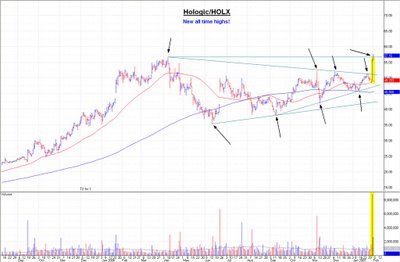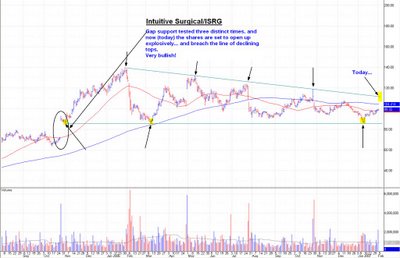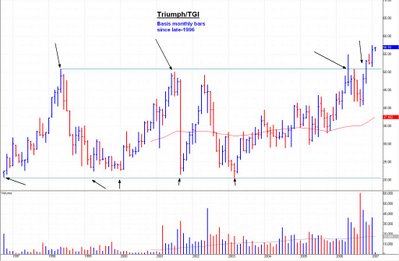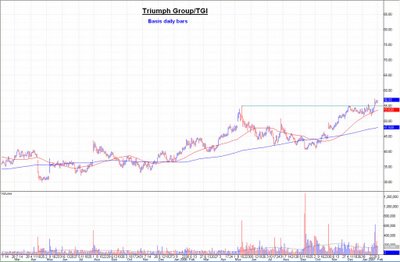Temporary panic attack
Not to appear coy, but I have little to add to my warnings stated several weeks ago. In fact, I note that as most market commentators attempt to explain the declines in global markets, each notes several key items that mimic the reasoning for my stated warnings; the difference is that they explain after the fact whereas I warned in advance. I find this difference crucial; you -- well, those of you who respect my mumblings sufficiently to adhere to them -- were prepared via reducing risk, and exposure. I suppose it to be silly, but for me to say more now would be akin to rubbing salt in an open wound.
I deem worth your attention, however, two explanations for yesterday's global market declines plus one statistical picture; each suggests clues and expectations investors should watch for from this moment forward.
First is a statistical table with related comments by Dorsey Wright...
=================================
Another thing we know about market volatility is that many of the “Best Days” and “Worst Days” for the market are often clustered together. It is these wild swings that get investors scared in the markets and cause irrational decision making. As you might imagine, a number of the best and worst days were clustered around the Crash of 1987. As well, 1998 had its fair share of high volatility days as did 2001 and 2002. Believe it or not, we did not just live through one of the "20 Worst Days for the Market", at least not by measure of the S&P 500/SPX. With a decline of 3.47% the S&P narrowly avoided making the list below.
 [click on each image to enlarge]
[click on each image to enlarge]
Highlights of Volatile Days
(Volatile Days are those which made the top 20 best or worst percentage move days since 1986)
• Over the past 20 years, 14 years did not have any of the 10 best days while 6 of those days occurred in 1987 and 2002.
• 1987 had 5 of the 20 worst days with 3 of those occurring in October.
• 10 years did not have any of the 20 worst days.
• 7 out of 9 Trading Days in 1987 were volatile days (4 down / 3 up)
• 2 out of 2 Trading Days in 1997 were volatile days (1 up / 1 down)
• One month in 1998 had 5 Trading Days as volatile (3 down / 2 up)
• 2 days in a week in 2001 were volatile days (1 up / 1 down)
• 8 days between July - October 2002 were volatile days (2 down / 6 up)
While Tuesday is just further evidence that no one can know in advance the best days and the worst days, having a solid game plan and sticking to a non-emotional strategy will enable an investor to achieve attractive returns in an environment of sound risk management. Address problem stocks as they arise, make sure your stop loss points are realistic and palatable if hit, and remember that this is nothing that we haven't seen before. The headlines are always a little different, but our reasons for taking action are not.
=================================
Equity markets took a drubbing today (yesterday), with the S&P 500 falling 3.5%, as bad news from several quarters undermined confidence.
Overseas, Chinese equities were down almost 10% as the government took steps to prick what is perceived to be an equity bubble amidst ongoing efforts to slow what is feared to be an overheating economy. It's ironic that China's problems stem ultimately from the fact that things are so good there. With massive reserves at its disposal, the Chinese central bank can virtually guarantee that its currency will not be devalued, thus truncating a potential source of downside risk for global investors. But it's even better than that, because the government has essentially conceded to U.S. demands that it revalue its currency against the dollar, and it has been doing so at a regular and predicable pace for over a year and a half. Here's the deal: the central bank has given the world a free put option on the yuan, and the government has given investors a free, in-the-money call option on the yuan. It's hard to pass up a bargain like that, so it's not surprising that the country should be flooded with liquidity, which in turn has been bidding up the prices of Chinese equities (up 130% in the past 18 months even after today's rout) and "overheating" the economy. The government is trying to slow things down, but that's a difficult task when investors still see asymmetrical rewards for investing there.
Meanwhile, back at home our markets were quite vulnerable to any unexpected, adverse developments. Implied volatility was very low in both stock and bond markets, risk premia were very low, and stocks had been moving straight up for the past seven months. First the bad news early this morning from China, then the bad news about an 8% drop in durable goods orders. Then the recollection that Alan Greenspan yesterday said a recession by the end of the year was a possibility. To cap things off, David Malpass in an op-ed in today's WSJ laid out the very real threat of a ratcheting upward of tax burdens over the next several years. And let's not forget the emerging consensus that fourth quarter GDP will very likely be revised down from 3.5% to 2.2% or so, making it clear that the U.S. economy decelerated from a 3.5% pace a year or so ago to what is now probably a 2-2.5% pace. Finally, despite scattered good news here and there, the housing downturn has not yet run its course and will likely remain a drag on growth for at least another 6 months.


Today's panic attack comes at a time when there are few, if any, signs of a dollar liquidity shortage. The dollar is weak, gold is strong, commodities are strong, and oil prices are up 500% from their 1998 lows, all in fact suggesting that dollar liquidity is generally abundant. The global economy is booming, corporate profits are robust all over the globe, and the market expects the Fed to ease 2 or 3 times over the next year or so. And to keep things in perspective, while we haven't had a 3.5% one-day selloff in the stock market for quite some time, such an event is not too unusual most of the time. Indeed, it's been the lack of volatility recently that has been remarkable. The bond market, meanwhile, remains quite calm.
So while the current panic might not pass for a few weeks, it seems unlikely to spiral out of control or trigger any serious repercussions in the economy.
=====================
And last (but never least) is this helpful snippet from today's commentary by the always-insightful, Tim Villano...
Yesterday's massive 3.47% decline for the S&P 500 Cash Index (SPX -50.33 1399.04) took out all downside stops, firstly (SPX 1450) and secondly (SPX 1436). Once again, the similarities to last year are notable as the entire creeping intraday wave-5 rise of the first quarter has been given back in short order. This vulnerability was most clear in the position of Commercial stock index futures traders, who have remained net-short throughout this period. Similar to last year, the entire first quarter appears to have been a game of chicken, which has cut short potential upside timing periods recently mentioned for the beginning of March.
From a data standpoint, yesterday's decline is comparable to some of the worst historic rapid market selloffs, including 1987. Three statistics point to the possibility of a developing selling climax.
1) Extreme low NYSE TICK Index readings, including a (-1033) figure, were recorded.
2) Yesterday was an impressive 98.5% down-volume session for the NYSE, which in part accounts for the closing NYSE TRIN reading (15.77).
3) Finally, the +64% rise in the CBOE Volatility Index (VIX +7.16 18.31) has historically been followed by some stabilization and short-term rebounding.
While these factors suggest that short-term support is likely on weakness during Wednesday's session, yesterday's break may signal the beginning of a bona fide daily wave-4 movement for major indices, which would mean a choppy and difficult trade following a process of stabilization and rebounding.
From a pattern standpoint, the NASDAQ 100 (NDX -74.32 1756.27) is in worse shape than the general market, indicating that rebounding into the (NDX 1780-1795) range will likely meet interim resistance. Short-term intraday patterns uniformly suggest that a test of lows or an unimpressive up-session cannot be ruled out on Wednesday but that rebounding is likely into the beginning of next week following more corrective activity today.
The Futures are rebounding sharply this morning but subject to more selling by the end of today's session. In other words, sharp upside this morning may be given back to a less certain settlement.
We view yesterday's decline as a return to normalized trading patterns from the uncomfortable extended rise of the past few months. According to the S&P 500 Cash Index, a daily wave-4 is now in effect, which could ultimately be followed by a test of highs or new highs. Such an event, should it occur, would likely conclude the bull market which began in March 2003 -- to be followed by a more difficult overall market environment perhaps in the second half of this year and into 2008.
Labels: Market analyses




























































































































